Forty-five years ago, the radical historian of science and technology David F. Noble observed a consistent pattern in modern American life: “Each major scientific advance, while appearing to presage an entirely new society, attests rather to the vigor and resilience of the old order that produced it.” Those words were written on the cusp of the personal computer revolution, which led to our dismally networked society of consumer-citizens addicted to disinformation and content-trash injected into our brain stems by powerful, pocket-sized devices, on hand at all times. Rather than delivering, in Noble’s words, on the “escalating promise of technological transcendence,” the twin forces of scientific technology and corporate capitalism gave rise to global behemoths—Microsoft, Apple, Facebook, Google, Amazon—that reproduced the same “corporate monopolization of technological intelligence” that marked the industrial age. We’re living in what Noble described in America By Design as “a remarkably dynamic society that goes nowhere.”
Can anyone possibly believe that this time, it’ll be different? Apparently so. For Baffler no. 64, “Reality Minus,” our writers find enthusiasts for all the latest varieties of technological utopianism. Virtual reality? Life in the metaverse? As Jeffrey Sconce notes, you will be expected to participate in this brave new world, and to like it. “For those who can pay, Club Zuck may well offer a few hours of diverting yet ultimately sad grinding in a hallucinated discotheque,” Sconce forecasts. Yet, how dispiriting to see “the human species continue to run away from itself, draining more and more enchantment from the real world just to prop up commodified fantasies of disembodied contentment in places that do not actually exist.”
But what about fantasy and fun? Lyta Gold recalls the holodecks on Star Trek as a model for high-tech, anything-goes escape. But in “No Sex for You,” she explains that in Mark Zuckerberg’s Meta-branded metaverse, sexual freedom will be way too complicated for designers to manage. The leisure activities Zuck’s envisioned for his virtual world are almost unbearably wholesome: “a child’s idea of utopia.”
That kind of arrested development distinguishes so many visionary tycoons leading us against our wishes into their idea of the future. Jacob Silverman zeroes in on the leading contender to become the new Brat-King of Twitter. Elon Musk might or might not end up owning his shiny toy, but in proposing to sink billions into a platform for short-form bloviating—a company that Musk uses to juice Tesla’s stock price but that for the most part creates nothing of value—one begins to wonder about the idea of wealth without worth. Noah Kulwin sees parallels between the savings-and-loan scandals of the 1980s and today’s cryptocurrency schemes. But at least the S&Ls helped people finance homes. Kulwin writes that in the world of cryptocurrencies, “it’s waste all the way down.”
Artificial intelligence, rule-by-algorithm, augmented reality . . . it’s not all in the distant future. As Lizzie O’Shea explains, it’s happening now, and these systems “provide cover to governments that prefer to spend money on technology-as-magic rather than grapple with social inequality and dysfunction.” Hannah Zeavin zooms in on algorithmic wizardry—specifically “affective computing,” wherein the already-booming AI industry births “surrogate humans,” bolstering “a fantasy of a future free of reproduction via reproduction, where the fear that automata will replace us is turned to a utopian dream of incorporation.” However they function, the message is the same: AI babies opt in so that humans can opt out.
It’s a natural human urge to invent new tools, of course. But for an example of how out of whack the corporate-driven technology market is, take a look at Laura Mauldin’s report on how people who depend on tech to get through the day—disabled people—are ill-served by both the public and private sector, especially in housing and health care. In the face of state and market failures, “caregivers and disabled people are left to crowdsource improvised hacks to navigate a world indifferent—if not outright hostile—to their actual needs and desires.”
For Black Americans, there is a similar problem. We now live in a relentlessly data-collecting society. Historians of the Black experience go back to the archives, though, and find information about property transactions and little about the human experiences of those who were denied their humanity. Data has always been a political tool. Shamira Ibrahim considers current efforts at “undisciplining data,” a necessary part of reanimating Black lives, and connects that concern to the ways modern data-collection and surveillance can deny the humanity, and human aspirations, of those on the margins.
Meanwhile, we never escape the celebration of the dynamic entrepreneur with a Big Idea. Nicholas Russell details Tony Hsieh’s attempts to remake downtown Las Vegas, once known as the “Implosion Capital of the World.” Hsieh made a fortune with Zappos, the online shoe retailer, and then became a self-appointed visionary of urban renewal. “He thought he could transform a city that’s perpetually in flux but utterly disinterested in genuine change,” Russell reports. Many of Hsieh’s plans were assumed to be “eco-friendly,” as is often the case with publicity-savvy business elites these days. They are ever in search of remedies that can be sold as wins for the environment but that are also “market friendly.” Finn West examines the idea of trading carbon credits in the global marketplace. Thus, Shell imagines itself becoming a “net-zero emissions energy business” by 2050—not by producing less oil and petrochemicals but by getting credits—for example, by planting more trees—that offset their emissions. It’s been a popular idea among polluters, supposedly “green” think tanks, and state regulators. Yet West argues that halting the increase in emissions doesn’t equate with reducing total emissions, which is what the climate emergency requires.
So much of what goes on in tech solutionism is, well, bananas. Which brings us back to the crypto craze. In a rollicking account of a recent road trip, Jasper Craven tells of crossing the highways of America in a rented truck hauling a lifesize Harambe gorilla statue, all for the purpose of setting up Harambe while dumping a load of bananas in front of Facebook’s headquarters. Why? An upstart company with a “crypto-fueled metaverse” business plan saw the opportunity for a publicity stunt they hoped would go viral. Craven admits that his initial reaction to the business plan was that “most start-ups seem to be solving problems that don’t exist.” The trip itself solved a problem for him, though: he was paid $5,000, and in cash, not crypto.
America has always been rife with pyramid schemes and scams. Elias Rodriques and Clinton Williamson show that sometimes the scammers are small-timers and sometimes they’re big businesses. Every technology brings new scamming techniques: the telephone did and so did the internet. Scams and “the confidence man” make for good stories; Herman Melville knew that. Still, Rodrigues and Williamson observe, “the scam genre tends toward the myopic, getting us to fixate on the wrong object. It insists that the confidence trick is an aberration rather than the norm.”
David Noble saw in our history of technology a pattern of “change without change.” That’s another way of saying that we are devoted to “innovations” nobody needs while we get nowhere, as Jeffrey Sconce puts it, in making “the decidedly non-Meta lives of most humans slightly less awful for the limited time we each have on this ridiculous planet.”











